This Khaman Dhokla recipe makes a wonderfully soft and fluffy, lightly sweet, spiced and savory gram flour cake that’s perfect to enjoy anytime of the day. It’s easy to prepare, quick and instant Khaman recipe steamed on the stovetop or even in the Instant Pot with my step-by-step photos, video and instructions.
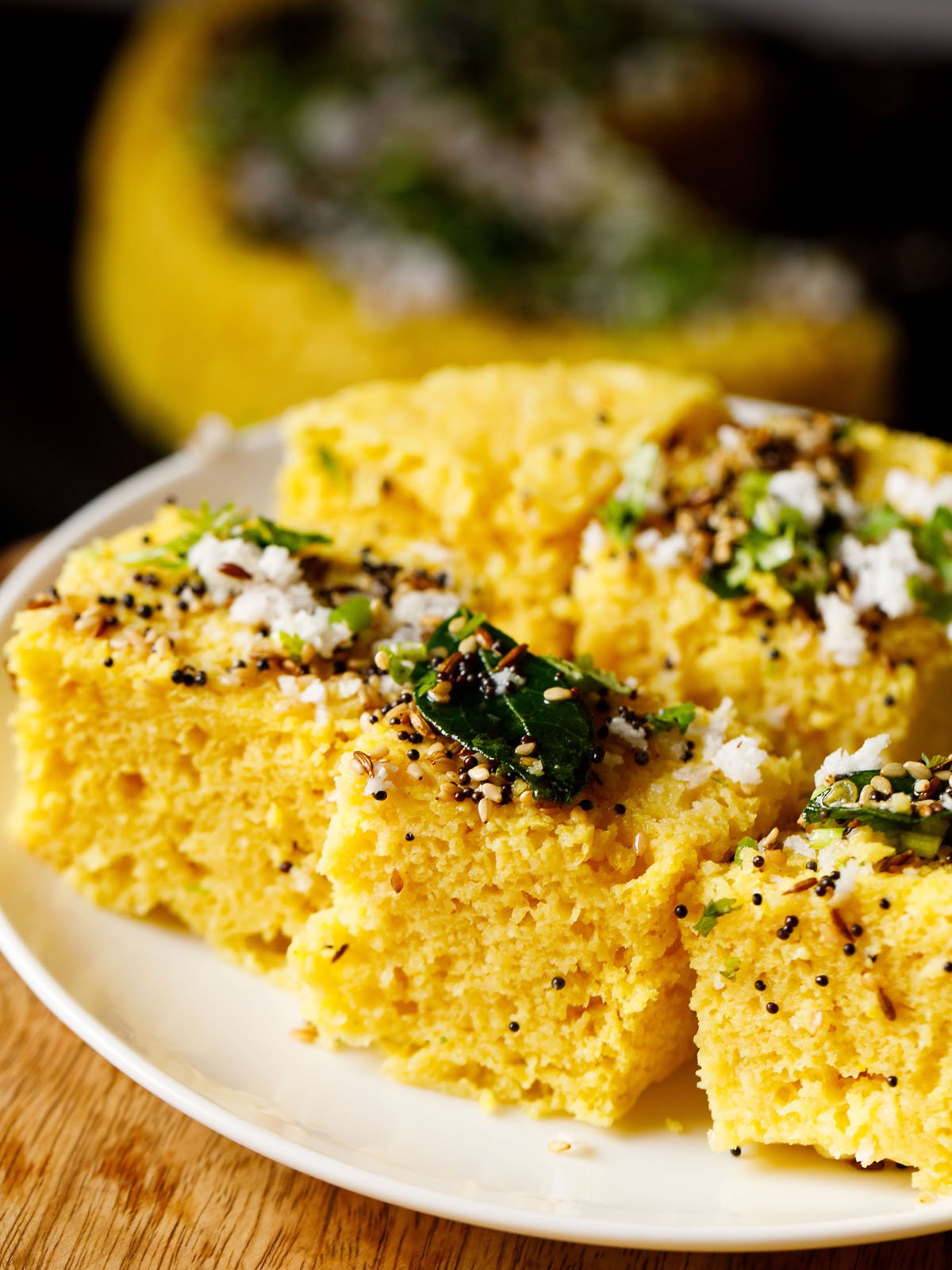
About Khaman Dhokla Recipe
Khaman, also known as Khaman Dhokla in other Indian states, is a popular delicacy from the Gujarati cuisine.
This popular light and spongy snack is made with a leavened batter of a spiced gram flour batter, that is later steamed in a pan. A tempering of spices and herbs is made which is then drizzled over this steamed cake.
This recipe makes a light, spongy dhokla and includes a hint of great savory flavor from a simple combination of gram flour (besan), spices, and herbs.
If you are wondering what is gram flour, it is simply is finely ground hulled black chickpeas. We also call it besan in Hindi.
Table of Contents
To leaven the batter instantly, there are a few ingredients you can use, that I have listed below. It is the reaction between the acidic lemon juice and the choice of leavening ingredient that aerates the batter, which helps in giving the Khaman its characteristic rise, softness and fluffiness.
Khaman is a healthy savory-sweet snack that happens to be vegan. Plus, it can be gluten-free too, if you skip semolina and asafoetida in the batter.
Khaman is also known as Yellow Dhokla as it has a yellow color or Besan Dhokla. It is also known as Instant Khaman.
I prepare Khaman Dhokla recipe with the steaming method either in an Instant pot or in a pan.
They’re perfect to enjoy for a hearty and satisfying breakfast or an afternoon or evening snack.
Dhokla vs Khaman
Khaman is popularly referred to as Khaman Dhokla but in actuality, a dhokla is made differently than khaman.
Dhokla is made with ground, fermented batter of rice and lentils like chana dal or urad dal. It is also called Vati Dal Dhokla in Gujarati.
While khaman recipe is made instantly with gram flour batter which is leavened by adding baking soda, citric acid or fruit salt. Khaman batter is not fermented unlike a dhokla batter.
The batter is leavened instantly using any of the leavening ingredients that you prefer. This leavened batter is then steamed in a greased pan like a steamed cake.
In the taste department, fermentation gives dhokla a really complex flavorsome taste, but a khaman also tastes equally great.
The color of dhokla can range from cream to light yellow or yellow but a khaman always has a bright yellow color.
Choice of Leavening Ingredients
To make soft and fluffy khaman dhokla you can choose between three leavening ingredients or a use a mix of two of them. Fruit salt, baking soda and citric acid are these ingredients and let us know more in detail about them.
1. Eno (Fruit Salt)
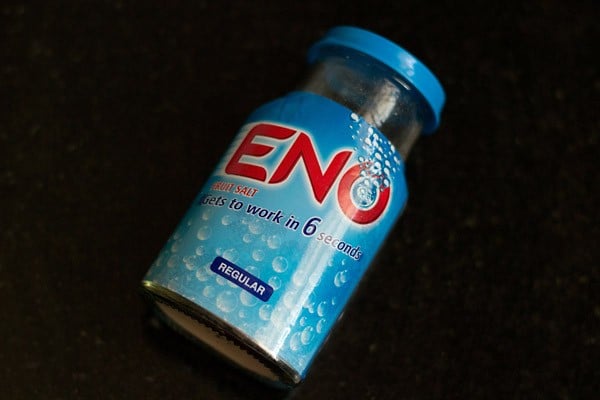
As a leavening agent, I use in this khaman recipe is fruit salt which results in a light and fluffy texture. Eno is a popular Indian brand of fruit salt that is used to relieve acidity and heartburn.
Fruit salt is composed of citric acid, sodium bicarbonate (baking soda), and sodium carbonate.
Sodium bicarbonate and sodium carbonate are effervescent ingredients that bubble and release carbon dioxide when added to water.
2. Baking Soda or Eno
To make khaman dhokla recipe, you can also use baking soda. But baking soda gives its soapy aroma if used in excess, so be careful not to add too much.
Eno gives you a perfect fluffy and soft khaman while the one made with baking soda is not that fluffy or spongy.
I personally prefer to use eno in khaman recipe as it gives the best results. I do not favor baking soda, as firstly we cannot stand the soapy aroma and secondly the texture is not that airy or spongy in comparison to the khaman dhokla recipe made with eno.
Use eno that is fresh and within its shelf period. If your eno is not fresh or active, the texture of khaman will be flat and dense. And please do not use flavored eno – the regular eno without any flavor works the best.
Both eno and baking soda react with turmeric powder and gives a red tinge or red spots in khaman dhokla. So add little turmeric powder or skip it completely.
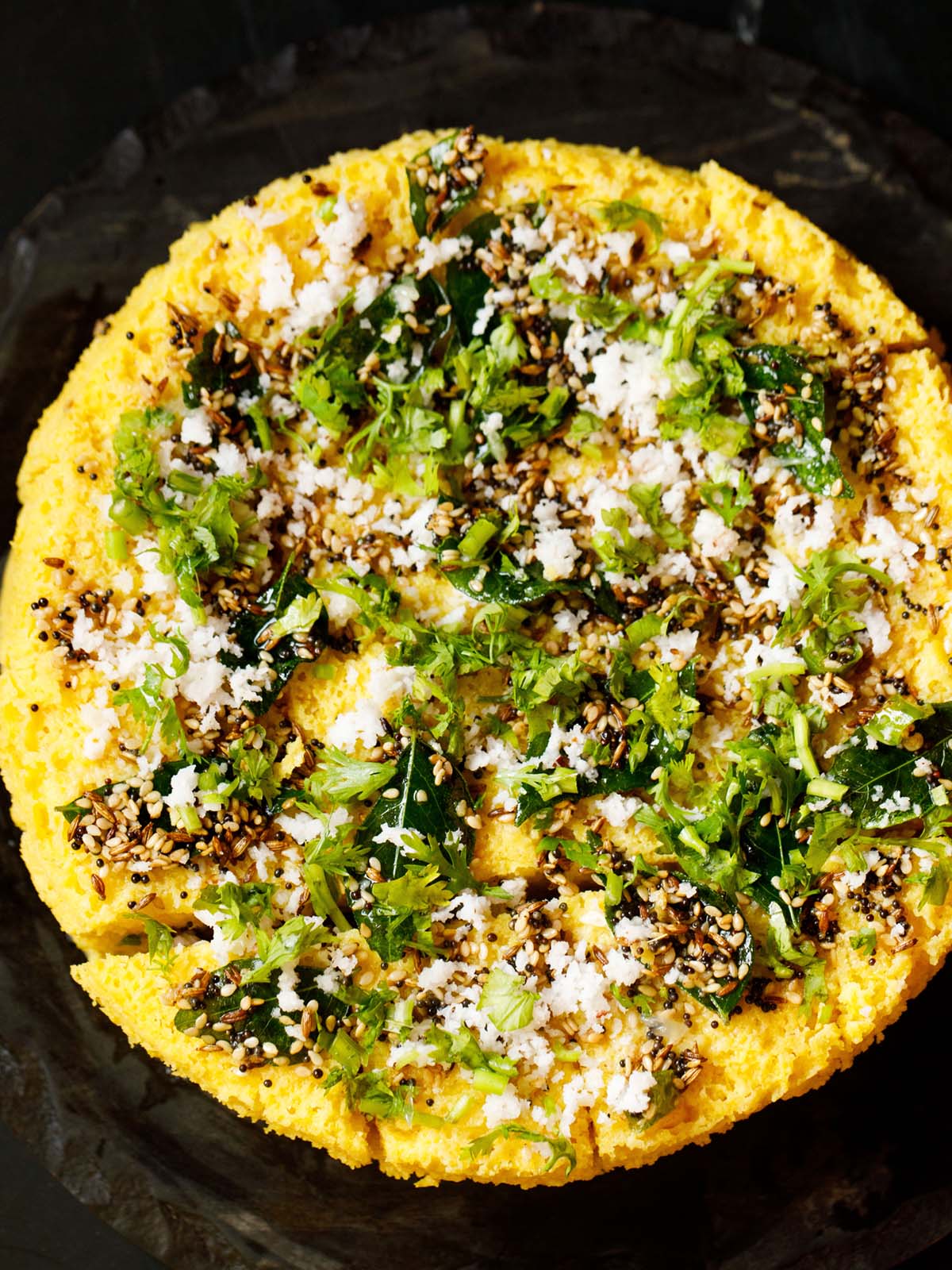
3. Lemon juice or Citric Acid
I have made khaman dhokla recipe both with lemon juice and citric acid. Citric acid gives a superb fluffy texture. Lemon juice also works great, but citric acid wins here. That said, use whatever is easily available to you.
To swap citric acid with lemon juice, use this standard proportion of:
1 tablespoon lemon juice = ¼ teaspoon citric acid (in the powdered form)
For citric acid, use a food-grade and pure citric acid. I also suggest including freshly squeezed lemon juice. Use a fresh lemon.
How to make Khaman Dhokla
Prep Pan
1. Grease a steamer pan with 2 to 3 teaspoons oil.
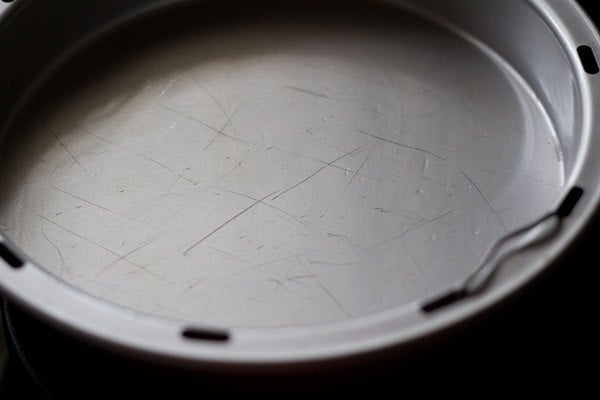
Make Batter
2. Take 1.5 cups gram flour (120 grams besan) in a mixing bowl or pan. Do use gram flour which has a fine texture.
Tip: You can make khaman with chickpea flour as well.
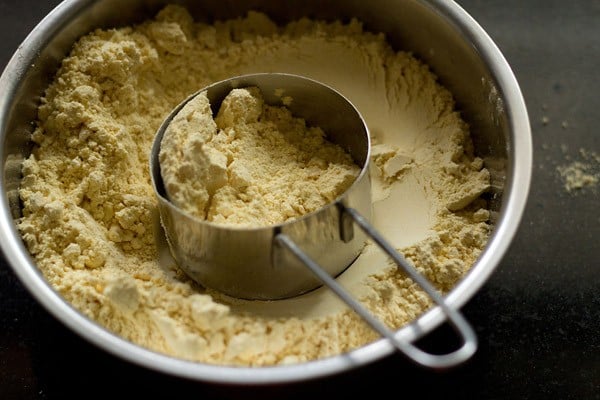
3. The add the following ingredients:
- 2 to 3 pinches of turmeric powder
- a generous pinch of asafoetida (skip to make a gluten-free version)
- 1.5 tablespoons lemon or lime juice or ⅓ to ½ teaspoon pure citric acid
- 1.5 teaspoons ginger paste (crush 1.5 inch ginger and 1.5 teaspoons green chilies in a mortar-pestle)
- 1.5 teaspoons green chili paste
- 1 tablespoon sugar or add according to taste
- 1 teaspoon salt or add as per taste
Tip: Avoid adding too much of turmeric powder as then the fruit salt or baking soda reacts with the turmeric powder and makes it red in color, thereby giving reddish dots, specks or tones in the khaman.
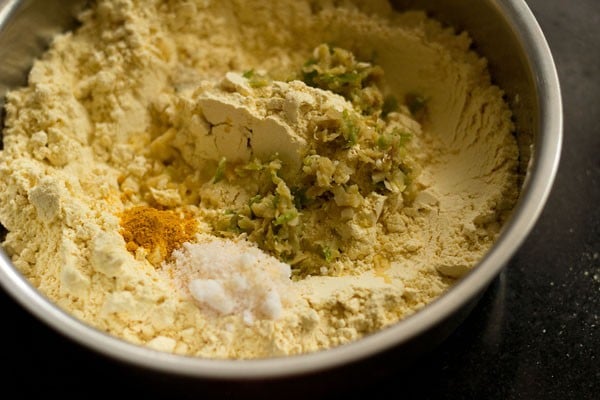
4. Add 1 cup water (or more or less as needed) and 1 tablespoon oil to make a thick yet smooth flowing batter.
The amount of water needed depends on the quality of flour, so start with 1 cup and add as required. Stir well to combine.
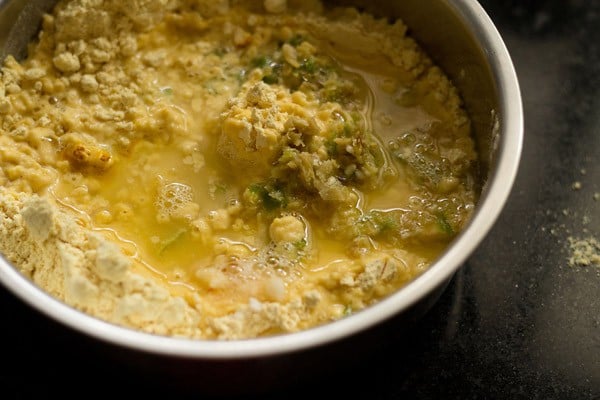
5. Then add 1 tablespoon rava (semolina). This is entirely optional but adds a good texture to the khaman. Skip rava or semolina for a gluten-free option.
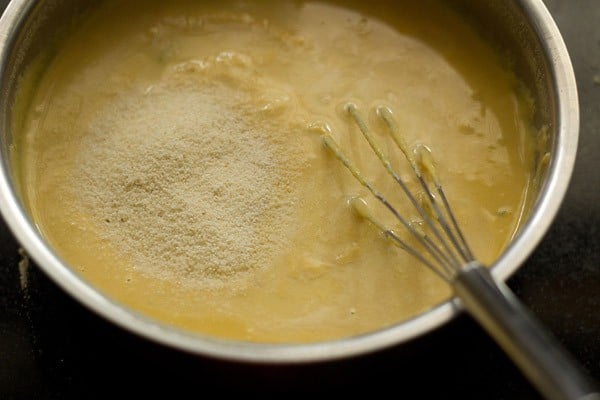
6. Stir with a whisk to create a smooth, thick batter without any lumps.
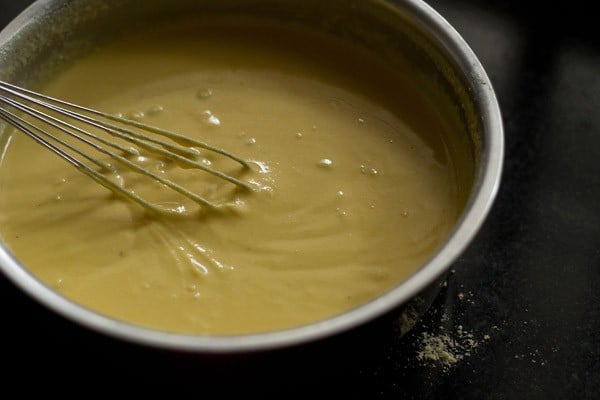
Batter Consistency
7. The batter should be thick yet flow easily off of the whisk. A quick tip is that if the batter becomes thin, then 1 to 2 tablespoons of gram flour.
Next bring 2 to 2.5 cups of water to a boil in a steamer pan or electric cooker or pressure cooker. The amount of water to be added depends on the size of the steamer or pressure cooker.
Note: To know more about the steaming in a pan, cooker and Instant Pot in detail, do read the tips section below.
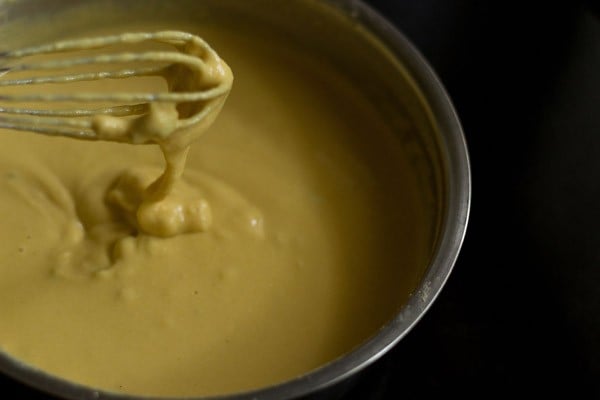
Leaven Batter
9. Next add 2 teaspoons Eno or fruit salt. 2 teaspoons of Eno makes the khaman soft and fluffy. But there is a slightly alkaline taste to Eno.
If you’re not a fan of this flavor then add only 1.5 teaspoons of Eno. If using baking soda as your leavening agent add ½ teaspoon to ¾ teaspoon.
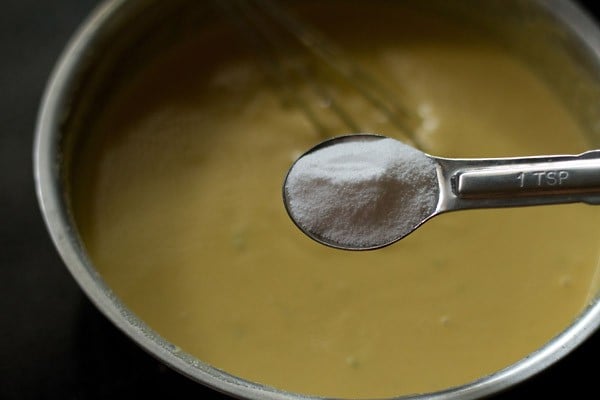
10. Stir and mix the eno with the batter briskly and quickly.
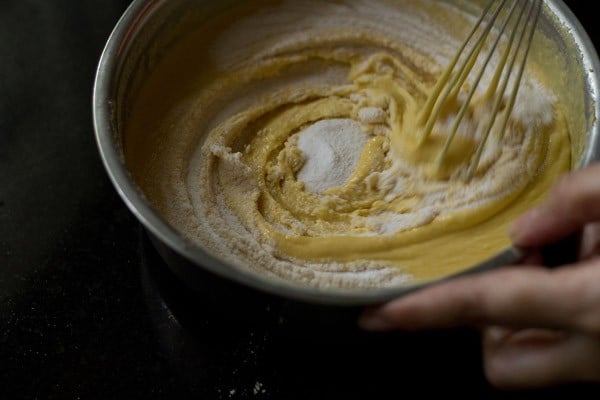
11. The fruit salt should be mixed evenly with the batter. Or else you get uneven texture in the khaman.
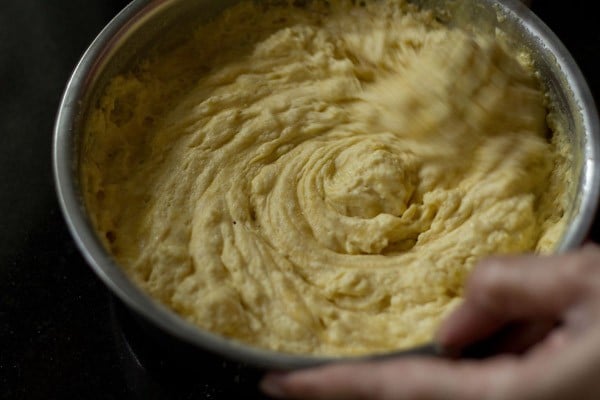
12. The eno will make the batter become frothy, so you need to work quickly to whisk it in thoroughly.
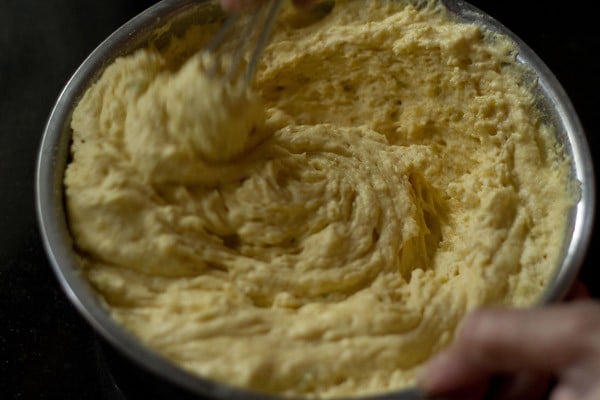
12. Pour the prepared batter into the greased pan.
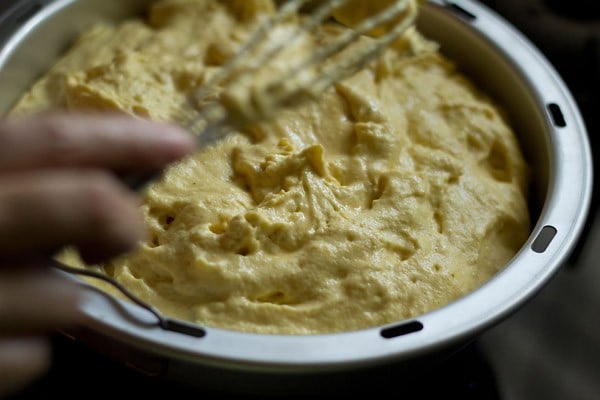
13. Gently shake so that the batter evens out in the pan. Below is a picture of the batter ready to be steamed.
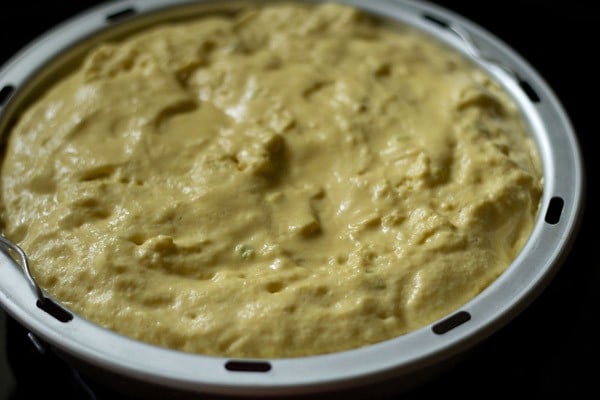
Steam
1. Place the pan in a steamer or electric rice cooker or pressure cooker. The water should already be boiling or hot when you place the pan with the khaman batter.
When using a pressure cooker, remove the vent weight/whistle from the lid and cover the cooker tightly with its lid.
Note: I have listed the detailed directions of steaming in a pan, pressure cooker and Instant pot in the tips sections below.
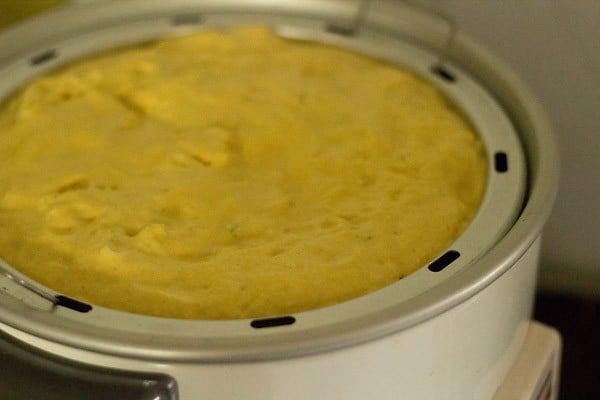
2. Steam for 15 to 20 minutes in an electric rice cooker. If using a pan or pressure cooker or Instant Pot, steam for 12 to 15 minutes on a medium to medium-high heat.
In the below photo the khaman is cooked for 17 minutes using an electric rice cooker.
You can begin working on the spice and herb solution for tempering the khaman while it cooks. Continue reading for the instructions.
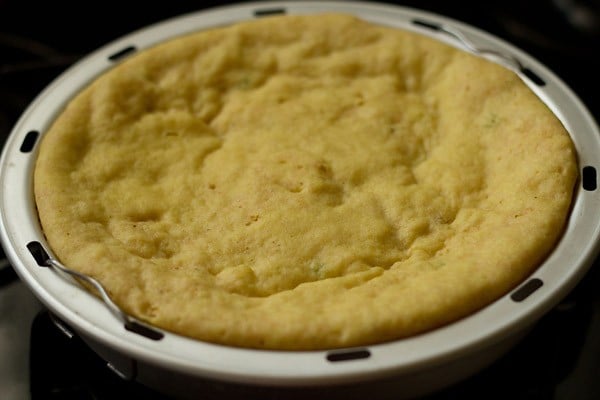
3. To check the doneness, insert a toothpick. It should come out clean if the khaman is done. If the toothpick has the batter on it, then you need to steam for another minutes or so.
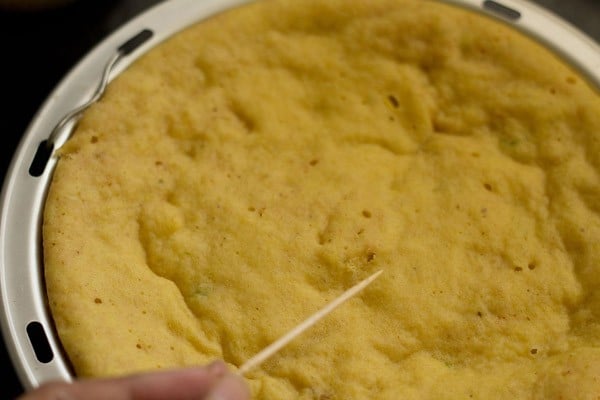
4. Let the khaman become warm or cool completely. Gently slide a butter knife along the edges to release the khaman from the pan. Place a plate or tray on top of the pan.
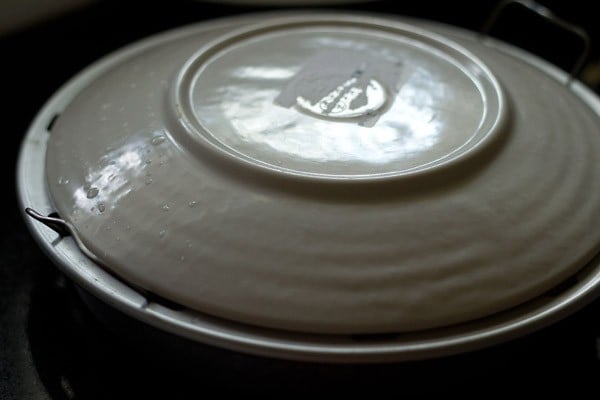
5. Then quickly invert the pan.
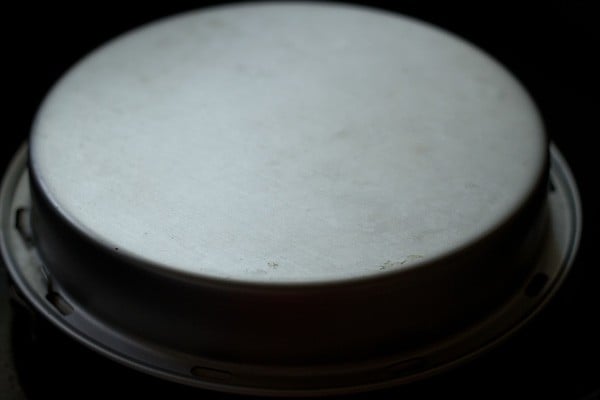
6. If greased well, the khaman will easily slide out onto the plate.
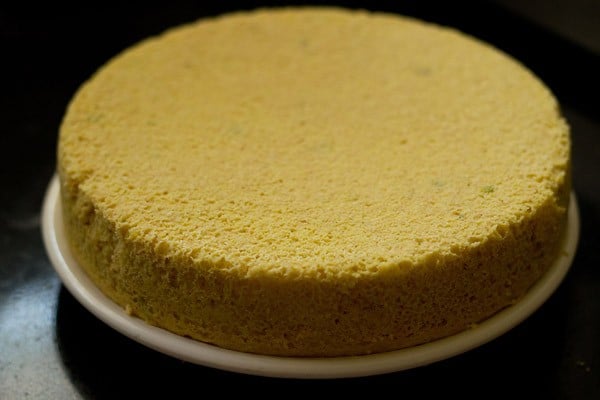
7. Use a sharp knife to slice the khaman in squares and set aside until ready to temper.
Since I used a concave plate, the khaman settled down in the center. This won’t happen if you use a flat plate.
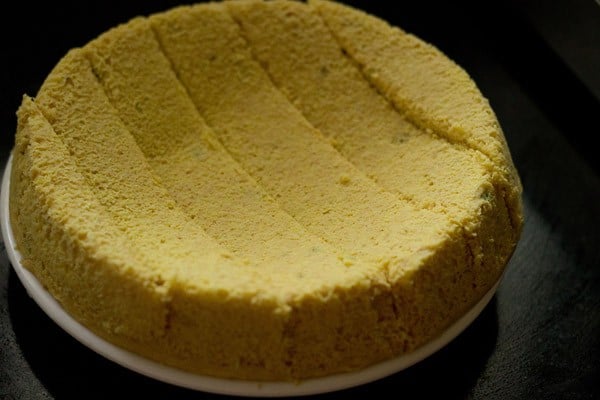
Temper Khaman Dhokla
1. Tempering is essential to infuse the khaman with flavor and add moisture to the gram flour sponge. To make the temper, first heat 2 tablespoons of oil in a small pan on the stove. Use peanut oil or any neutral-tasting oil.
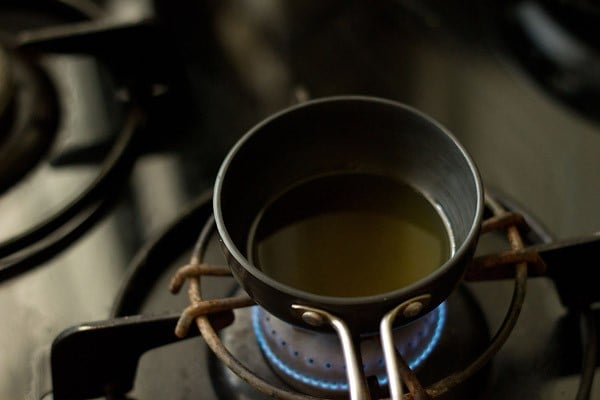
2. Add 1 teaspoon of mustard seeds and allow them to crackle.
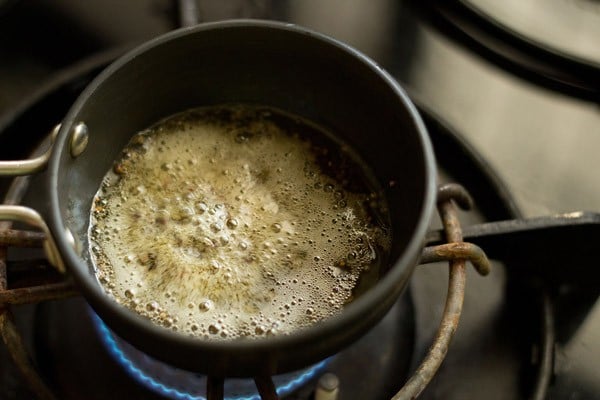
3. When the mustard seeds are crackling, add 10 to 12 curry leaves, and, if you like, 1 teaspoon of cumin seeds and 1 teaspoon of chopped green chili.
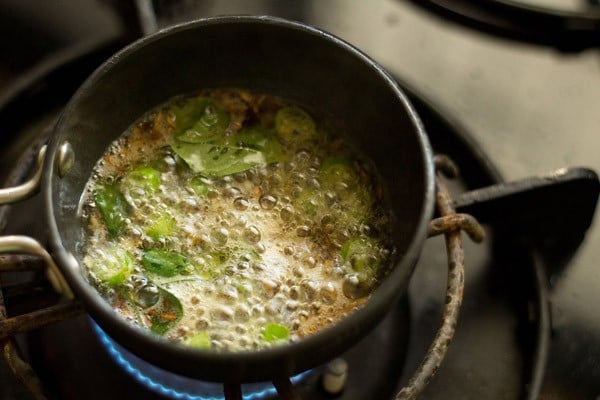
4. Stir and then add 2 teaspoons white sesame seeds.
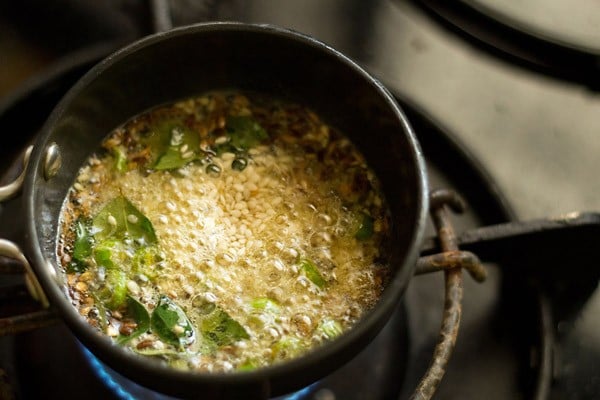
5. Fry the sesame seeds for some seconds. But don’t brown them or they’ll become bitter.
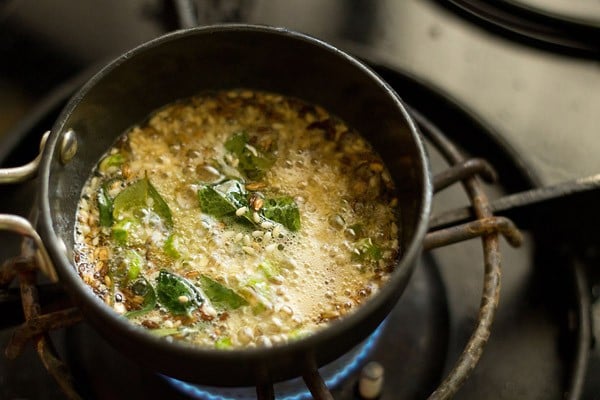
6. Next carefully add ⅓ cup of water. You can switch off the heat when adding water.
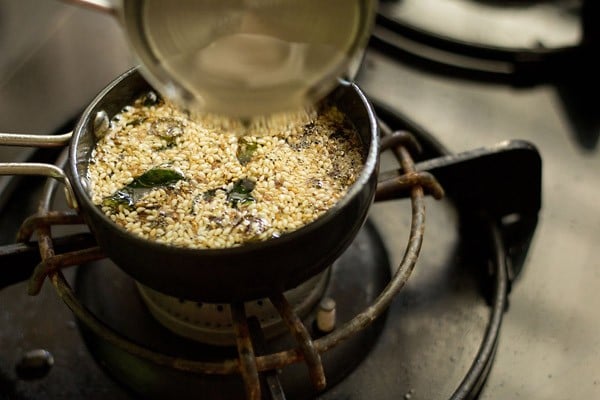
7. Next add 2 teaspoons of sugar.
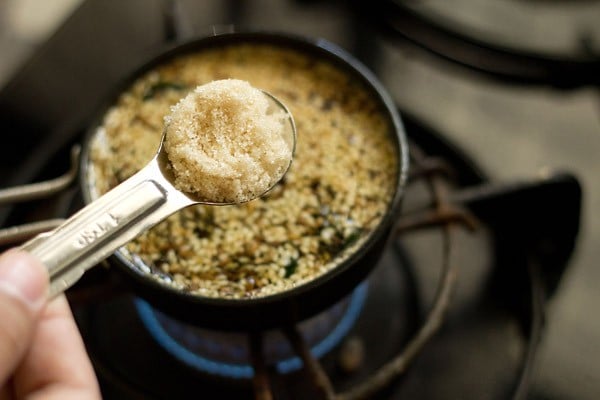
8. Stir and allow the tempering mixture to come to a boil. Make sure that the sugar is dissolved.
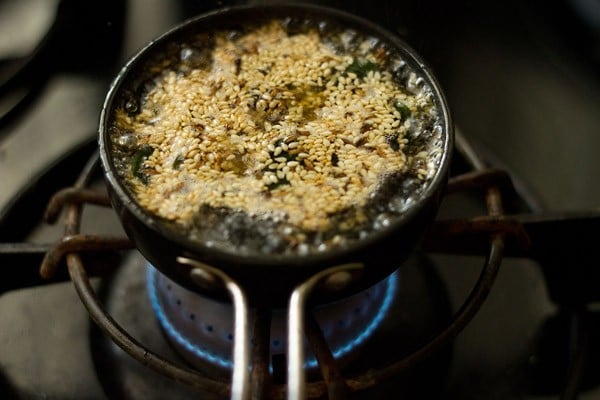
9. Remove from the heat and immediately pour this tempering mixture evenly on the khaman dhokla so that it seeps through the sliced edges.
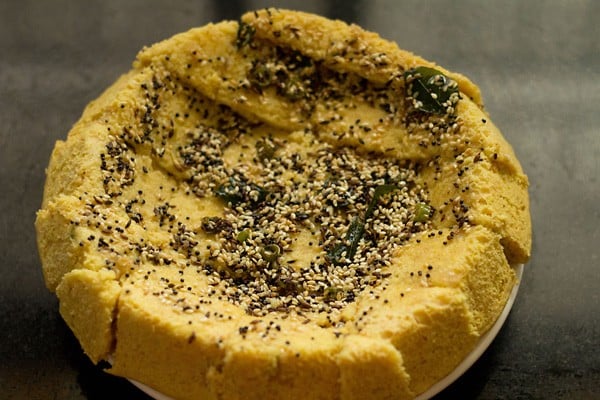
10. Garnish with 2 to 3 tablespoons of chopped coriander leaves and 2 to 3 tablespoons grated coconut, if you like.
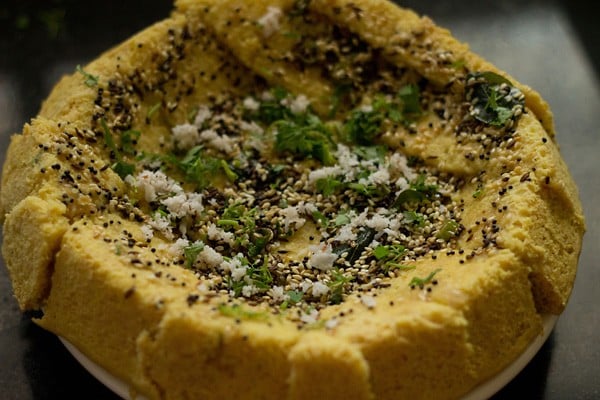
Serving Suggestions
Serve the Khaman Dhokla straight away or you can store it in an airtight box and serve later after an hour. If enjoying khaman later after several hours, then don’t add coconut until ready to eat.
You can also refrigerate them, and then when ready to serve just sprinkle some water and heat in a microwave for a few seconds until just warmed.
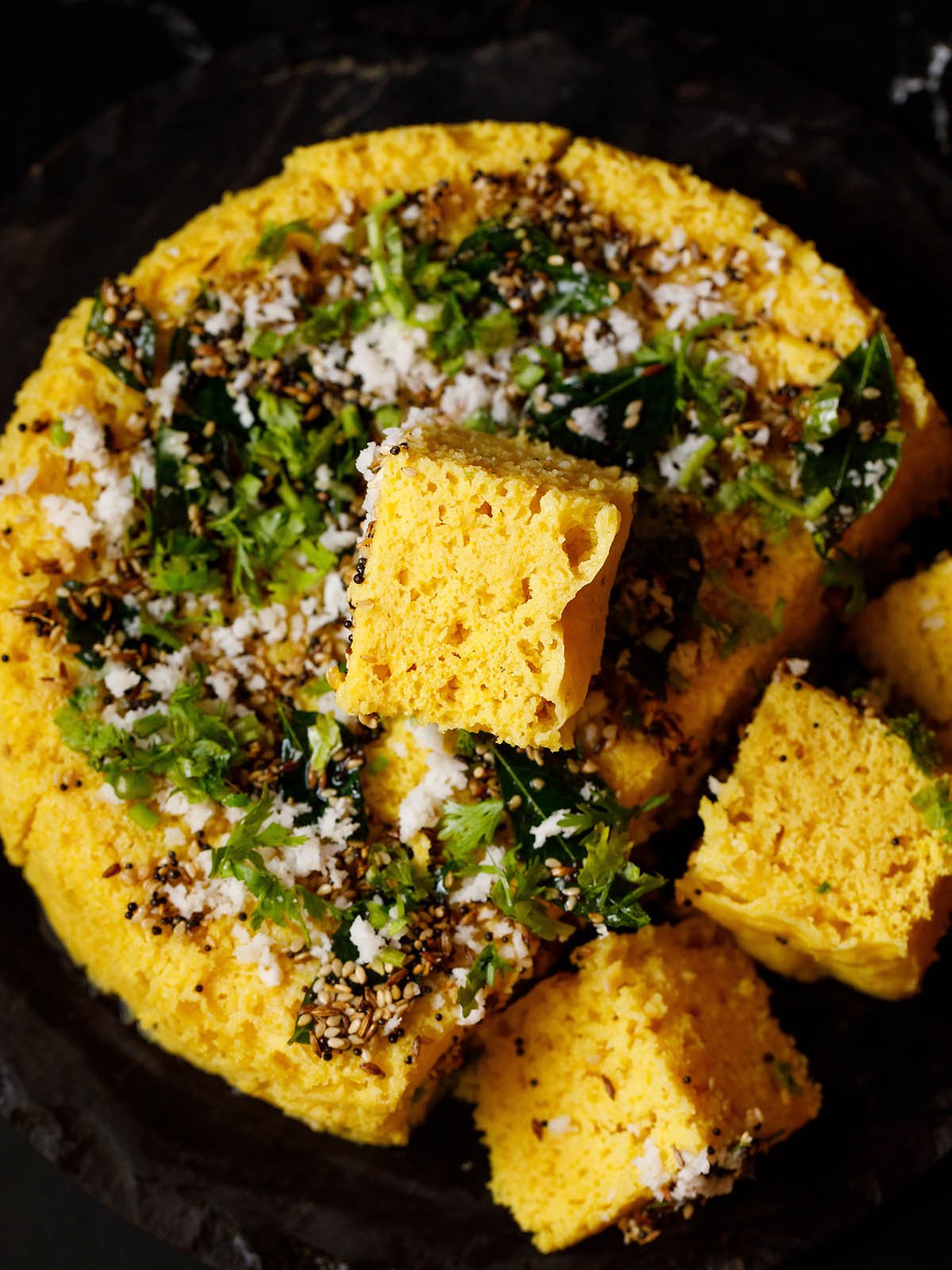
What to eat with Khaman
The sweet, savory, fluffy cakes pair great with our usual assortment of Indian chutneys like Papaya Chutney, Mint Chutney, or even Coriander Chutney.
We also like to pair it with Tamarind Chutney. You can also serve it as a healthy snack with your evening chai.
Storing Suggestions
If you plan to serve khaman after a few hours or next day, then I do not recommend to add coconut or coriander. Simply pour the tempering.
Refrigerate the khaman in a covered container. While serving you can warm with a sprinkling of water in a microwave or an oven.
If using the instant pot to warm, then steam for 1 to 2 minutes. While serving add the coconut and coriander leaves.
Expert Tips
Batter Consistency: The batter consistency has to be flowing but thick to medium-thick. 1 cup water with 1.5 cups of gram flour, always gives me perfect results, but you can add a few tablespoons of water if your batter looks very thick. A super thick batter will make the khaman hard and dense. A thin batter won’t hold shape and will become a mess.
Leavening Ingredient: Feel free to use any of the leavening ingredient. I usually make Khaman Dhokla recipe with eno. Simply ensure that your leavening ingredient is fresh and within its shelf period.
Flavor Adjustments: Khaman always has a sweet and tangy flavor. If you do not prefer the sweetness, I would suggest reducing the sugar but do not omit it entirely. The sweetness balances the tangy taste. You could though add the spices like green chillies and ginger according to your preferences.
Steaming: In a standard pan of 7 to 8 inches, it will take about 12 to 15 minutes for the batter to steam in a pan. Avoid overdoing the steaming as this may result in your Khaman becoming dry and crumbly.
Three Steaming Techniques
You can steam khaman in a pan, stove-top pressure cooker, or in an Instant Pot. I list below in detail on steaming khaman in each.
1: Steaming in a pan or pot
1. Place a small trivet in a large steaming pan that has enough room to keep the pan with the batter. Pour 2 to 2.5 cups of water. Bring it to a boil.
2. Place the batter pan as soon you mix with eno. Cover with a lid (not tight fitting) but one that has a vent or will allow some steam to pass through.
3. Steam for 12 to 15 minutes on medium-high heat. The deeper the pan is in touch with the boiling water, the faster the steaming is. If it is away from the boiling water, the steaming will take a bit more time.
2: Steaming in a stove-top pressure cooker
1. Place the trivet in a pressure cooker. Add 2 to 2.5 cups water. Heat the water until it begins boiling. Secure the pan tightly between tongs and carefully place it on the trivet.
2. Remove the whistle (vent weight) from the lid and seal the lid tightly. Steam for 12 to 15 minutes on medium to medium-high heat.
3: Instant Pot Steaming
1. Pour 2 to 2.5 cups of water in the steel insert of your IP. Place a trivet (not short or long, but kind of in between).
2. Use the sauté function and let the water get heated up and start simmering.
3. Using tongs or with oven mitts carefully place the pan with the khaman batter on the trivet. Do not cover with any lid.
4. Cover and seal IP with its lid and keep the vent position to steam release. Press the steam button and steam on high pressure for 12 to 15 minutes.
5. Keep a check of the time using a clock or watch as Instant pot does will not beep after the elapsed time and will continue to steam. Let all the pressure release and the valve fall down. Then open the lid carefully.
FAQs
The sponginess and light texture in the instant khaman dhokla recipe comes from reaction of eno with lemon juice or citric acid releasing carbon dioxide.
This reaction creates a fizzy bubbly mixture that helps the batter to rise and leaven thereby making it fluffy and spongy when steamed. So if you use less leavening agents (eno, baking soda) or if they are not fresh or active, your khaman won’t be spongy.
Turmeric powder reacts with baking soda or eno to give orange or red colored spots or patches in khaman dhokla. This makes your khaman turn orange or red. This can be avoided by adding less turmeric powder to the batter.
It can be eaten warm or at room temperature.
Adding too much of leavening ingredients like baking soda can make your dhokla bitter.
More Popular Gujarati Snacks!
Gujarati Food Recipes
Snacks Recipes
Gujarati Food Recipes
Gujarati Food Recipes
Please be sure to rate the recipe in the recipe card or leave a comment below if you have made it. For more vegetarian inspirations, Sign Up for my emails or follow me on Instagram, Youtube, Facebook, Pinterest or Twitter.
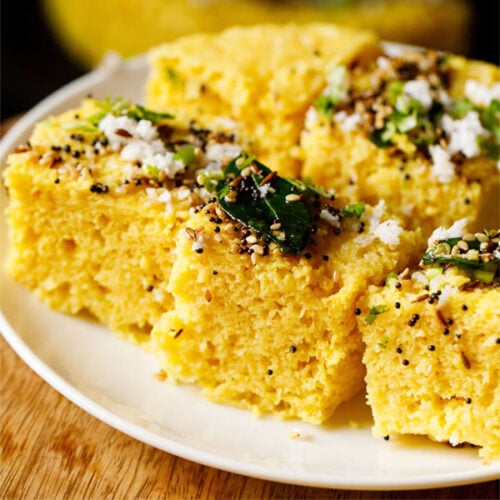
Khaman Dhokla Recipe (Instant Gujarati Khaman)
Ingredients
For khaman batter
- 1.5 cups gram flour (besan), 180 grams
- 1 tablespoon rava (semolina) – optional
- 1 tablespoon sugar
- 1.5 inches ginger – crushed to a fine paste in a mortar-pestle
- 1.5 teaspoons green chillies – chopped and then crushed to a fine paste in a mortar-pestle
- 2 to 3 pinches turmeric powder (ground turmeric)
- 1 to 2 pinch asafoetida (hing)
- 1 tablespoon oil – any neutral oil or peanut oil
- 1.5 to 2 teaspoons eno (fruit salt) or ½ to ¾ teaspoon baking soda
- 1 teaspoon salt or add as required
- 1.5 tablespoon lemon juice or ⅓ to ½ teaspoon pure food grade citric acid
- 1 cup water or add as required
For tempering khaman dhokla
- 2 tablespoons oil – any neutral oil or peanut oil
- ⅓ cup water
- 1 teaspoon mustard seeds
- 1 teaspoon cumin seeds – optional
- 2 teaspoons white sesame seeds
- 1 sprig curry leaves – about 10 to 12 curry leaves
- 1 teaspoon green chilies – chopped, optional
- 2 teaspoons sugar or add according to taste
For garnish
- 2 to 3 tablespoons coriander leaves – chopped (cilantro)
- 2 to 3 tablespoons coconut – grated and fresh, optional
Instructions
Making khaman batter
- Grease a steamer pan with 2 to 3 teaspoons of oil.
- Take besan or gram flour in a mixing bowl or pan.
- Add turmeric powder, asafoetida, lemon juice, ginger paste, green chilies paste, sugar, oil and salt.
- Add 1 cup water or as required to make thick yet flowing water. The amount of water required depends on the quality of flour, so add as required.
- Stir and then add the rava or sooji (semolina).
- Stir to a smooth thick batter without any lumps.
- The batter should be thick yet flowing. A quick tip is that if the batter become thin, then add 1 to 2 tablespoons besan.
- Bring to a boil 2 to 2.5 cups of water in a steamer pan or electric cooker or a stove-top pressure cooker.
- The amount of water to be added depends on the size of the steamer or pressure cooker.
- Now add the eno or fruit salt to the batter.
- Stir briskly and quickly. The fruit salt should be mixed evenly with the batter. Or else you get uneven texture in the khaman.
- The batter would froth and become bubbly, so you have to be quick.
- Pour the batter in the greased pan.
Steaming khaman dhokla
- Place the pan in a steamer or electric rice cooker or pressure cooker. The water should already be boiling or hot when you place the pan with the batter. When using pressure cooker, remove the vent weight/whistle from the lid and cover the cooker tightly with its lid.
- Steam for 15 to 20 minutes in an electric cooker. If using a pan or pressure cooker, steam for 12 to 15 minutes on a medium to high heat.
- To check the doneness, insert a toothpick and if it comes out clean, the khaman is done. If the toothpick has the batter on it, then you need to steam for some more time.
- When the khaman become lukewarm or cool, then with a butter knife gently slid along the edges. Keep a plate or tray on top of the pan.
- Invert the pan. If greased well, the khaman will easily get inverted on the plate. Slice and keep aside.
Tempering
- In a small pan, heat oil.
- Add mustard seeds and let them to crackle.
- When the mustard seeds are crackling, add the cumin seeds (optional), curry leaves and chopped green chilies (optional).
- Stir and then add sesame seeds.
- Fry the sesame seeds for some seconds but do not brown them.
- Then add water. Be careful while adding water as the mixture sizzles. You can switch off the heat when adding water.
- Add sugar. Stir and allow the tempering mixture to come to a boil. Make sure that the sugar has dissolved in the water.
- Then pour this tempering mixture evenly on the steamed and sliced khaman.
- Garnish with chopped coriander seeds and grated coconut.
- Serve khaman dhokla straight away or you can store them in an air tight box and then serve later after some minutes or an hour.
- If serving khaman after many hours, then do not garnish with coconut and coriander leaves.
Serving Suggestions
- The sweet, savory, fluffy cakes pair great with any spicy or sweet Indian chutney.
- You can also serve it with your evening chai.
Storing Suggestions
- If you plan to serve khaman after a few hours or next day, then I do not recommend to add coconut or coriander leaves. Simply pour the tempering.
- Refrigerate the khaman in a covered container. While serving you can warm with a sprinkling of water in a microwave or an oven.
- If using the instant pot to warm, then steam for 1 to 2 minutes. While serving add the coconut and coriander leaves.
Video
Notes
Ingredient Notes
- Eno: Use the regular plain eno without any flavors.
- Gluten-free: For making khaman gluten free, skip the asafoetida and semolina.
- Baking soda or Eno: The ingredient which we use to leaven the khaman batter is fruit salt. Eno is a popular Indian brand of fruit salt. You can also use baking soda. However baking soda gives the soapy aroma if used in excess. Again both eno and baking soda react with turmeric powder and gives a red tinge or red spots in khaman. So add little turmeric powder or skip it completely.
Recipe Notes
1. Batter consistency The consistency of the batter is flowing but thick to medium-thick. 1 cup water with 1.5 cups of gram flour, always gives me perfect results, but you can add a few tablespoons of water if your batter looks very thick. A super thick batter will make the khaman hard and dense. A thin batter won’t hold shape and will become a mess. 2. Steaming Methods You can steam khaman in a pan, stove-top pressure cooker, or in an Instant Pot. I list below in detail on steaming khaman in each. a) Steaming in a pan or pot- Place a small trivet in a large steaming pan that has enough room to keep the pan with the batter. Pour 2 to 2.5 cups of water. Bring it to a boil.
- Place the batter pan as soon you mix with eno. Cover with a lid (not tight fitting) but one that has a vent or will allow some steam to pass through.
- Steam for 12 to 15 minutes on medium-high heat. The deeper the pan is in touch with the boiling water, the faster the steaming is. If it is away from the boiling water, the steaming will take a bit more time.
- Place the trivet in a pressure cooker. Add 2 to 2.5 cups water. Heat the water until it begins boiling. Secure the pan tightly between tongs and carefully place it on the trivet.
- Remove the whistle (vent weight) from the lid and seal the lid tightly. Steam for 12 to 15 minutes on medium to medium-high heat.
- Pour 2 to 2.5 cups of water in the steel insert of your IP. Place a trivet (not short or long, but kind of in between).
- Use the sauté function and let the water get heated up and start simmering.
- Using tongs or with oven mitts carefully place the prepared pan with the khaman batter on the trivet. Do not cover with any lid.
- Cover and seal IP with its lid and keep the vent position to steam release. Press the steam button and steam on high pressure for 12 to 15 minutes.
- Keep a check of the time using a clock or watch as Instant pot does will not beep after the elapsed time and will continue to steam. Let all the pressure release and the valve fall down. Then open the lid carefully.
Nutrition Info (Approximate Values)
This Khaman Dhokla recipe from the archives was first published on August 2012. It has been updated and republished on June 2024.
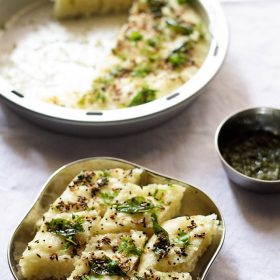
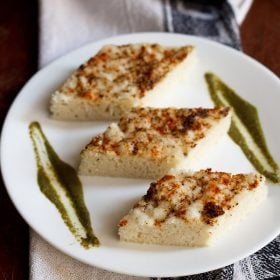
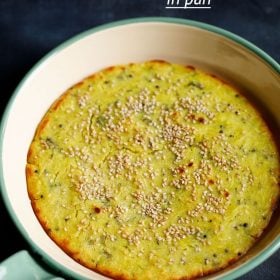
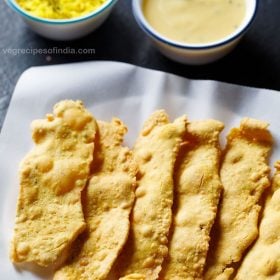
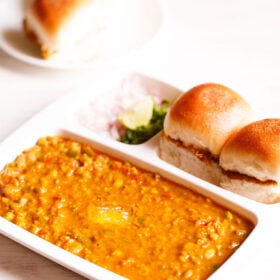
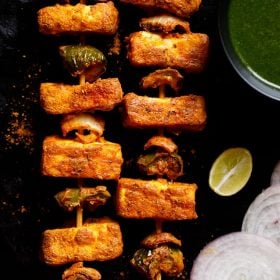
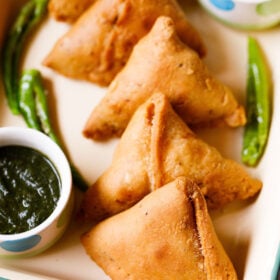
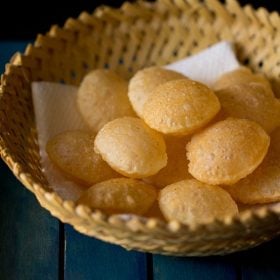








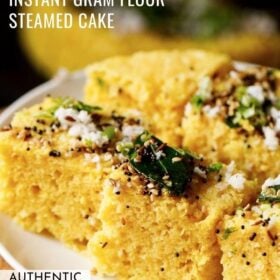
Hi dassana.. I have tried many recipes from your site and they turned out to be really tasty.. only thing I had a problem with thia dhokla recipe is that mine didn’t come out fluffy.. it didn’t rise at all.. it was just like a besan base and little sticky.. what could be the reason? I felt very disappointed. .
you use eno or baking soda. the eno or baking soda, must be past its shelf life and not active. thats why the dhoklas did not turn out fluffy and sticky.
Awessssom recipe… Worked out very nicely…
Thnq once again 🙂
welcome always pooja, thanks for positive views 🙂
Thank you for sharing the recipe…
We are planning to try it out but there’s one thing I need to get clarified…
For steaming the dhokla, can I use any usual stainless steel container? Or does it have to be an aluminium one? I wouldn’t mind much the shape…
And while steaming, can the pan be rested in the boiling water? I don’t have any hanging-above arrangement in my pressure cooker.
Thank you
welcome ruchi. you can use any steel container. but just grease it well, so that the dhokla comes out easily without getting stuck. yes, the pan can be rested in boiling water. do make sure that when the water is boiling, it does not fall on the dhokla batter inside the pan. the water should just touch 1 to 1.5 inch of the pan from the bottom.
Thank you for the help on procedure!
I tried the recipe today but the dhokla was uncooked except the top layer (then i went on to steam further for over an hour hoping that it’d get done but with no success)… I’ve tried many recipes from your blog and they all turn out great so I am suspecting my steaming method… if you could just verify if it’s alright..
In the cooker, after pouring water, I placed an inverted perforated plate over which I placed the utensil/mould containing dhokla batter. I covered the mould with another small plate to prevent steam from getting in touch with batter directly (since the mould was lying at a much lower level than cooker height).
Then I closed the cooker with its lid sans whistle and went ahead with steaming.
Was the steaming method alright? [sorry if it all sounds stupid, actually we have never tried any steamed dish at home like idli, dhokla etc]
welcome ruchi. looks like some water has gone in the batter while cooking. so the base is batter like and the top has got cooked. you can keep the flat jali round base that we get with pressure cooker at the bottom and then place the dhokla batter pan on top of it. cover with a lid while steaming. some steam outlet should be there, while steaming, so do not cover tightly, the way we cover when cooking rice or lentils.
using the perforated plate is fine. thats what i mentioned above. but do not cover the dhokla batter pan with a lid. keep it open. also secure the cooker lid tightly, but do not use whistle. looks like since you kept a lid on the pan, steam has formed in the pan and the batter looks uncooked. so my above reasonings are not right. also cooked height does not matter. if you want you can keep a heat proof stand inside the cooker and place the bowl on the stand.
Hi Amit
Thank you for your easy yet amazing recipes, I was in hostel after school for 10years for studies and at home also was never interested in going to kitchen, had always been a spoilt baby,, now after marriage I started learning recipes slowly and gradually and enjoying doing that rather, me n my husband both are big foodies thank you so much you saved me with your recipes with photos, ps. My inlaws visited us and your Punjabi kadhi, dhokla, chilly mushroom etc recipes were loved by each n everyone at home and got me so much appreciation
Welcome Swati. Glad to know that recipes are helping you in learning cooking. Feel free to ask any query about recipes posted. I will be glad to help you.
I once made the microwave version and was a hit.. Can we make this without eno.. And is there any possibility of making the recipe by grinding chana dal and fermenting it like idli batter?
thanks ashrita. there is a method of grinding chana dal and fermenting like idli batter. soak 1 cup chana dal first for a few hours. then grind with some ginger and green chilies to a paste. the batter should have a rava like consistency in the ground chana dal. add water as required while grinding to make a thick batter like idli batter. then add 1 to 2 tablespoons of curd or 1/2 tablespoon lemon juice in the batter along with salt and mix well. cover and ferment overnight or 6 to 7 hours. then make dhoklas. but here you do need to add some baking soda. so for 1 cup of chana dal, you can add 1/4 to 1/3 teaspoon baking soda. hope this helps. you can also add cumin seeds and a pinch of hing while grinding chana dal.
Thank you so much for such a detailed reply dassana.. U really rock in this.. I would try it for soon and would let you know.. Btw I’m a regular reader and I swear by your recipes.. Have made Palak paneer, cookies, cauliflower curry, methi ke paranthe and a lot more to list.. And till date no recipes from your space has turned me down.. Keep rocking..
thanks ashrita for trying so many dishes and for positive views.
Hello mam. .u r wonderful in teaching people about cooking. I made this recipe yesterday night It came out out soft and delicious. Credit goes to you.
I have one question my hubby said he ate dhokla somewhere where they took dhokla out of water to serve.i didn’t get this.do u know anything about water he is talking about.will be very helpful
thanks seerat for the feedback. i am not aware about taking dhoklas out of water. i have never seen such a thing 🙂
hello Dassana!
i just cooked this awesome dhokla and it came out sooooo delisiously we couldt stop eat till last crumble. I used 1/2 tsp soda coz in russia we dont have fruit salt but there was no hint of alcaline in dhokla…. i was a little bit worry about 1/3 cup of water for tempering coz i bothered that dhokla would become loose and watery but i trusted you blindly as usual and it came out perfect!! it was melting in mouth soft and spongy.
you have a great gift – to cook and to teach. (and to take fabulous food photo!))))please keep teaching and inspiring us!
thank you sooo much!!!
very pleased to know this ksenia 🙂 glad your folks liked the khaman dhokla. thank you for your kind and encouraging words. you are always welcome.
Hii i always follow ur recipes and they come very tasty.my doubt is if we steam it like idli can we cover it with lid
yes you have to cover with a lid. but there should be an outlet for the steam to pass in the lid.
hello mam,I want to ask you that when i make dhokla in microwave it does not prepare well.It makes spongy but somewhere dry and wet on a same loaf of dhokla although i put too much water on it. Kindly help me out
could be that the microwave oven is not cooking the dhokla evenly. should not actually happen. what you can do is microwave at a low to medium power. so that the dhokla remains soft and does not get dry and also cooks evenly.
Hello love your recipes.. While making dhokla my dhokla just gets cooked at upper level.. At bottom dhokla remains uncooked. Y does this happens?? Please tell me.
thanks priyanka. actually it should not happen. the water which is used for steaming should not go into the batter or some other issue. not easy to guess.
Thanks for providing simple steps, dhokla came out very soft
thanks for sharing this saras 🙂
I made it after very long time, forgotten my recipe, not remembered
ok thankyou 🙂
Thankz for this recipe. Came out very well-soft, fluffy and yummy 🙂
thanks for the positive feedback bindu.
thanks for the receipe….I tried but didnt get tht fluffy…wht can be the reason for the same
could be that the eno or baking soda must not be active/fresh or past their shelf life. for any recipe that use eno or baking soda, always use them fresh and within their expiry date.
Hai..i alwys visit ds site…its a superb site helps us to improve our cooking skills..dhokla one f ma fav dish…i am frm Kerala..dhokla s nt available here .i had t from Mumbai..i wish to make t…i hav one doubt…shoul i use baking soda instead f eno??? Or eno s compulsory fr dhokla..??plz reply…thank u sithara
you can use baking soda. but at times with baking soda, you can get orangish reddish color in the dhokla. this is due to the reaction between turmeric and baking soda.
Hi,
I want to try this recipe in rice cooker but the steam pan is not as you have shown i pictures..it has holes in it so what do I use in that case?
please reply soon n thank u
the steam pan with holes is used for steaming veggies. i would not suggest using this steam pan for steaming dhokla. you can use any other bowl or pan which can fit inside this steaming pan which you have.